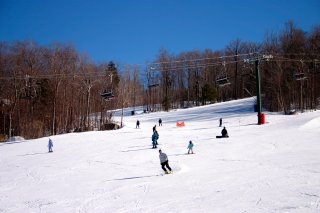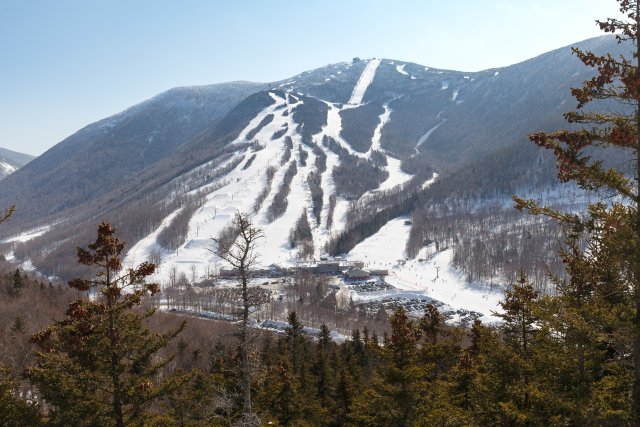Climate Change Connections: New Hampshire (Skiing)
Climate change is impacting all regions and sectors of the United States. The State and Regional Climate Change Connections resource highlights climate change connections to culturally, ecologically, or economically important features of each state and territory. The content on this page provides an illustrative example. As climate change will affect each state and territory in diverse ways, this resource only describes a small portion of these risks. For more comprehensive information about regional climate impacts, please visit the Fifth National Climate Assessment and Climate Change Impacts by Sector.
On this page:
Introduction: Snow Sports Play Important Role in New Hampshire’s Economy
The mountains of New Hampshire are a year-round destination for visitors and locals seeking recreation and beauty. Winter is an especially popular time as people take to the slopes and trails to participate in snow-based sports like downhill skiing, cross-country skiing, snowmobiling, and snowboarding. New Hampshire is home to 19 ski areas.1 Many of these ski areas are located in the White Mountains, which encompass nearly a quarter of the state. The White Mountains include White Mountain National Forest and the Presidential Range, which features Mount Washington, the tallest peak in the Northeast, known for its particularly fearsome weather and high winds. Given the popularity of skiing, it’s no surprise that it is New Hampshire’s state sport.2

Winter tourism and snow sports contribute significantly to the economy in New Hampshire, as well as the economies of neighboring states Vermont and Maine.3 Visitors come from near and far to hit the slopes and enjoy the beautiful mountain scenery. Proximity to major population centers like New York City and Boston also makes New Hampshire a popular snow sports destination. The economic impact of the winter sports industry includes direct spending on recreation activities and the associated industries that support them, including lodging, restaurants, and retail. In 2023, it’s estimated that nearly 3 million people visited New Hampshire (which has a population of 1.3 million) in the winter and spent over $1 billion.4
Climate Impacts: Warming Temperatures Expected to Further Threaten Snowpack and Snowfall
As the climate continues to change, temperatures are warming in northern parts of the United States. As in other places, New Hampshire has seen greater warming in the winter; since 1900, winter temperatures in New Hampshire have risen by more than 4°F.5 Changing winter temperatures directly influence the amount of snow that falls and accumulates, amount of seasonal snowpack, timing of snowmelt runoff, forest health, and soil moisture conditions.6
While warming temperatures and an increased ratio of precipitation falling as rain instead of snow are negatively affecting snowfall and snowpack across most of the country, the impacts vary by location. The Northeast and Midwest are projected to experience more significant reductions in snow sport season length compared with Western regions like the Rockies and Sierras, in part due to comparatively lower elevations.7 Warming winter temperatures and reductions in snowpack have negative implications for winter sports like skiing and snowmobiling.8

Weather, along with season length and timing, matters greatly for snow-based recreation. A major documented and projected climate impact in the region is a shorter winter recreation season. Some studies have estimated that in order to be economically viable, ski facilities must operate for at least 100 days a season.9 The month of December, particularly the week between Christmas and New Years, is an economically critical period for many ski operations due to the high volume of visitors.10 With predicted warming, ski season length is projected to decrease significantly by midcentury, with a majority of ski areas in New England failing to be open for 100 days and less likely to be open during the Christmas–New Year holidays.10 The reduction in season length, particularly the economically critical period in December, is expected to have profound implications for winter tourism and the sports economy in New Hampshire and neighboring states.
Artificial snow has long been used to complement natural snow and ensure consistent snow availability during ski season. Snowmaking involves a machine that pressurizes water and sprays snow onto the slopes. However, snowmaking still requires temperatures to be below freezing and does not work if temperatures are too high. Warming temperatures have been linked to a reduction in days with conditions suitable for snowmaking, particularly during the early season in December.11
Taking Action: Preparing for Warmer Winters
Addressing climate change requires reducing greenhouse gas emissions while preparing for and protecting against current and future climate impacts. Communities, public officials, and individuals in every part of the United States can continue to explore and implement climate adaptation and mitigation measures. In New Hampshire, local agencies and the snow sports industry are taking steps to adapt to and understand the impacts of a changing winter for the region, including:
- Diversifying year-round recreational opportunities. With shorter seasons for snow-based recreation, it’s expected that many facilities will work to enhance alternative year-round, or “off season” (non-winter) recreation opportunities to increase revenue.12,13 Ski facilities may pursue a variety of measures, including offering more indoor activities, leveraging ski lift infrastructure for scenic views, and adapting trails for hiking and mountain biking to draw visitors when there’s no snow on the ground.
- Making artificial snow. The practice of artificial snowmaking is already being leveraged to supplement natural snow and it’s expected to expand with less snowfall.11 While artificial snow can supplement natural snowfall, it can’t happen in non-freezing temperatures. While it may be an adaptative strategy, the process can also have environmental impacts. Snowmakers that run on fossil fuels emit greenhouse gases and pumping groundwater to make snow removes water from a source that is slow to recover. While state-of-the-art technologies can make snow production more energy efficient, increased use could strain local resources.11
- Conducting ongoing research. In addition to threats to winter recreation and associated economies, the changes in snowpack and soil frost are expected to impact the health of forest ecosystems in New Hampshire.14 The Hubbard Brook Experimental Forest Study has conducted long-term data collection and collaborative studies in the Hubbard Experimental Forest, located in the White Mountains.15 The study has collected data about forest ecosystems for over six decades, and though not originally collected for this purpose, the synthesis of some of these records can provide valuable insights into climate trends and indicators.15,16 The Hubbard Forest is an important resource for continued research about the relationship between warming temperatures, changing snowpack, soils, water quality, and forest health in a changing climate.
To learn more about climate change impacts in New Hampshire and the Northeast region, see Chapter 21 of the Fifth National Climate Assessment.
Related Resources
- EPA Climate Change Indicators: Seasonal Temperature
- EPA Climate Change Indicators: Snowfall
- New Hampshire State Climate Summary 2022 (NOAA)
References
1 NH Department of Business and Economic Affairs, Division of Travel and Tourism Development. (n.d.). Winter in NH. Visit NH. Retrieved February 13, 2024, from https://www.visitnh.gov/seasonal-trips/winter
2 State of New Hampshire. (n.d.). State sport, New Hampshire Almanac. Retrieved February 15, 2024, from https://www.nh.gov/almanac/sport.htm
3 New Hampshire Employment Security, Economic and Labor Market Information Bureau. (2020). The impact of outdoor recreation on New Hampshire’s economy. https://www.nhes.nh.gov/elmi/products/documents/ec-0320-article.pdf
4 New Hampshire Department of Business and Economic Affairs. (n.d.). Record setting summer tourism season. Retrieved August 12, 2024, from https://www.nheconomy.com/news-press/record-setting-summer-tourism-season
5 Runkle, J., Kunkel, K. E., Easterling, D. R., Frankson, R., Stewart, B. C., & Spaccio, J. (2022). New Hampshire state climate summary 2022 (NOAA Technical Report NESDIS 150-NH). NOAA National Environmental Satellite, Data, and Information Service. https://statesummaries.ncics.org/chapter/nh/
6 EPA. (2022). Climate change indicators: Seasonal temperature. Retrieved June 11, 2024, from https://www.epa.gov/climate-indicators/climate-change-indicators-seasonal-temperature
7 Wobus, C., Small, E. E., Hosterman, H., Mills, D., Stein, J., Rissing, M., Jones, R., Duckworth, M., Hall, R., Kolian, M., Creason, J., & Martinich, J. (2017). Projected climate change impacts on skiing and snowmobiling: A case study of the United States. Global Environmental Change, 45, 1–14. https://doi.org/10.1016/j.gloenvcha.2017.04.006
8 Domke, G. M., Fettig, C. J., Marsh, A. S., Baumflek, M., Gould, W. A., Halofsky, J. E., Joyce, L. A., LeDuc, S. D., Levinson, D. H., Littell, J. S., Miniat, C. F., Mockrin, M. H., Peterson, D. L., Prestemon, J., Sleeter, B. M., & Swanston, C. (2023). Ch. 7. Forests. In A. R. Crimmins, C. W. Avery, D. R. Easterling, K. E. Kunkel, B. C. Stewart, & T. K. Maycock (Eds.), Fifth National Climate Assessment. U.S. Global Change Research Program. https://doi.org/10.7930/NCA5.2023.CH7
9 Scott, D., Dawson, J., & Jones, B. (2007). Climate change vulnerability of the US Northeast winter recreation– tourism sector. 13, 577–596. https://doi.org/10.1007/s11027-007-9136-z
10 Dawson, J., & Scott, D. (2013). Managing for climate change in the alpine ski sector. Tourism Management, 35, 244–254. https://doi.org/10.1016/j.tourman.2012.07.009
11 Wilson, G., Green, M., & Mack, K. (2018). Historical climate warming in the White Mountains of New Hampshire (USA): Implications for snowmaking water needs at ski areas. Mountain Research and Development, 38(2), 164–171. https://doi.org/10.1659/MRD-JOURNAL-D-17-00117
12 Lemcke-Stampone, M. D., Wake, C. P., & Burakowski, E. (2022). New Hampshire climate assessment 2021. The Sustainability Institute. https://scholars.unh.edu/sustainability/71
13 Scott, D., & McBoyle, G. (2007). Climate change adaptation in the ski industry. Mitigation and Adaptation Strategies for Global Change, 12(8), 1411–1431. https://doi.org/10.1007/s11027-006-9071-4
14 Campbell, J. L., Ollinger, S. V., Flerchinger, G. N., Wicklein, H., Hayhoe, K., & Bailey, A. S. (2010). Past and projected future changes in snowpack and soil frost at the Hubbard Brook Experimental Forest, New Hampshire, USA. Hydrological Processes, 24(17), 2465–2480. https://doi.org/10.1002/hyp.7666
15 Hubbard Brook Ecosystem Study. (n.d.). Hubbard Brook Ecosystem Study: Long-term ecological research in the northern hardwood forest. Retrieved February 13, 2024, from https://hubbardbrook.org/
16 Campbell, J. (Ed.). (n.d.). Climate change. In Hubbard Brook Ecosystem Study. https://hubbardbrook.org/online-book-chapter/climate-change/

